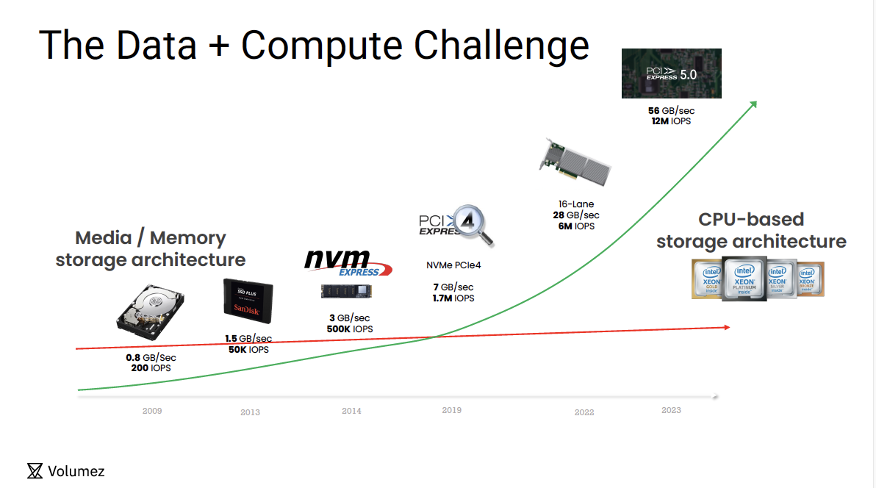While the cloud may be eating the world, it is not digesting storage very well. Cloud providers apply significant innovation to compute, memory, and networking — compelling reasons for running workloads on their platforms – but they languish when it comes to storage. Using traditional controller approaches to shared infrastructure they attempt to deliver performance and availability to demanding workloads but increasingly create 20th century storage problems with unpredictable performance, poor utilization, waste, and cost.
Professionally I grew up in the halls of the early storage kings: VERITAS and VMware/EMC. For more than 2 decades, enterprise workloads have run on VMware or some vestige of VERITAS. In this time and alongside these industry titans, entire storage systems evolved with the central concept of a controller fronting capacity. Control was needed to share capacity. And sharing capacity meant managing shared access and resource contention. But why share capacity at all? Because capacity was expensive and problematic to scale discretely. My career has been dedicated to the storage industry tradition of building increasingly elaborate and complex controllers to meet these challenges of shared access and scale. In joining Volumez I’ve found an iconoclastic solution that leaps ahead of traditions slugging out pathways with diminishing returns. I have lost my religion.
I hope the many amazing colleagues I’ve worked with over the years don’t read this as some kind of manifesto. But performance numbers Volumez generates for cloud infrastructure users make it so: 1.5 million IOPS, 300 microsecond latency, 12 GB/sec in the public cloud per volume! While maximizing utilization and moving the economics of persistent storage to a different realm altogether. Read that again: IN THE PUBLIC CLOUD PER VOLUME.
Hero numbers these are not. They reflect Volumez support for actual database and K8s workloads in production environments where three other factors come into play further differentiating Volumez:
- Predictable and guaranteed latency
- Elimination of noisy neighbor/resource contention
- Dramatically improved and predictable cost
This is data infrastructure created by the founder of Volumez, Jonathan (“Yoni”) Amit. Throughout his career, Yoni has built multiple storage controllers and created a massive intellectual property portfolio. Among the many storage deities I’ve worked with, he carries an exceptional architectural drive to refine, reduce, and simplify. His fundamental insight is the foundation of Volumez: the traditional controller is a dead-end – and hiding in plain sight in the public cloud is a composable data infrastructure drawn from Linux components battle-hardened and available right in front of us.
Composable infrastructure is not new. It’s been around a few years in infrastructure circles, long enough to have a market segment designation and analyst following: Composable/Disaggregated Infrastructure (“CDI”). In its early incarnation, CDI focused on blade chassis management. But the recent emergence of CXL has opened the door to new forms of high performance and adaptable CPU and memory configurations enabled through composable architecture approaches to the datacenter and cloud platforms. Modern workloads, like AI/ML, require the scale and elasticity created by disaggregation at the component level. Lagging in this next generation processing platform is storage. And this is where Volumez enters.
Composability is incomplete without the ability to compose data infrastructure. Today’s CPU-based storage architectures, whether implemented as centralized controllers or software defined storage (“SDS”) systems, cannot keep up with the underlying advancements in the media/memory components they are designed to manage:

Volumez closes this gap with its control plane, which separately composes (cloud provider) instance-based storage to form a Linux-based data path. Volumez’ unique approach applies intelligence to data path composition, aligning data infrastructure components to the specific workload demands for performance, availability, and cost. Policies can be created through the Volumez UI or API for block and file services, particular to the I/O characteristics of databases or AI/ML workloads, for example. The result is unprecedented performance and economics for operating an enterprise’s most important applications in public cloud platforms.
Volumez delivery in the public cloud for data infrastructure feels a lot like the fundamental disruptions I’ve had the privilege of working on in my career, such as virtualization. Unlike virtualization, however, this disruption can be measured in the hard metrics it produces. It has impacted me personally: my belief system around centralized control of data access is gone. Maybe you can teach an old dog new tricks, after all.
While I may have lost my religion, I have not lost the core values I carry for finding meaning and purpose in work life. Magic happens when you find 2 things: a difficult, outlandish market-sized problem and an amazing group of people to work on solving that problem. Yoni and Volumez’ CEO, Amir Faintuch, epitomize this life view and have assembled a unique team with hundreds of years of experience in major storage systems delivery, talent that has drawn legendary investors to a recent Series A funding round. I am incredibly excited and grateful to be joining this high velocity team. Compose on!
